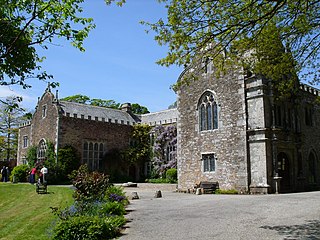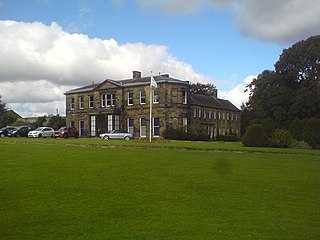
Farnley Hall is a stately home in Farnley, west Leeds, West Yorkshire, England. It is a grade II listed building. It was built in Elizabethan times by the Danbys. The manor is recorded in the 1086 Domesday Book as Fernelei, so it is probable that this house was a replacement for earlier medieval structures.

Leigh is a town in the Metropolitan Borough of Wigan, Greater Manchester, England, on low-lying land northwest of Chat Moss.
Culcheth is a village in the Borough of Warrington, England, six miles (10 km) north-east of Warrington town centre; it is the principal settlement in Culcheth and Glazebury civil parish.

Astley is a village in the Metropolitan Borough of Wigan, Greater Manchester, England. Within the boundaries of the historic county of Lancashire, it is crossed by the Bridgewater Canal and the A580 East Lancashire Road. Continuous with Tyldesley, it is equidistant from Wigan and Manchester, both 8.3 miles (13.4 km) away. Astley Mosley Common ward had a population of 11,270 at the 2011 Census.

Golborne is a town in the Metropolitan Borough of Wigan, in Greater Manchester, England. It lies 5 miles (8.0 km) south-southeast of Wigan, 6 miles (9.7 km) northeast of Warrington and 14 miles (22.5 km) to the west of the city of Manchester. Along with the neighbouring village of Lowton, it had a population of 24,041.
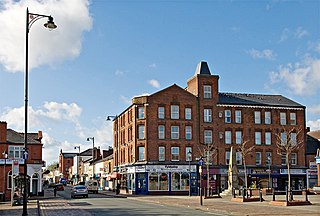
Tyldesley is a market town in Metropolitan Borough of Wigan in Greater Manchester, England. Within the boundaries of the historic county of Lancashire, it is north of Chat Moss near the foothills of the West Pennine Moors, 8 miles (12.9 km) southeast of Wigan and 9 miles (14.5 km) northwest of Manchester. At the United Kingdom Census 2001, the Tyldesley built-up area subdivision, excluding Shakerley, had a population of 16,142.

Culcheth and Glazebury is a civil parish in Borough of Warrington, Cheshire, England. At the 2001 census, it had a population of 8,534.

Freckenham is a small rural village and civil parish in the West Suffolk district of Suffolk in East Anglia, in the country of England.

Sir Gilbert Gerard was a prominent lawyer, politician, and landowner of the Tudor period. He was returned six times as a member of the English parliament for four different constituencies. He was Attorney-General for more than twenty years during the reign of Elizabeth I, as well as vice-chancellor of the Duchy of Lancaster, and later served as Master of the Rolls. He acquired large estates, mainly in Lancashire and Staffordshire.

The Manor of Clifton was a historic manor situated near the City of Nottingham, England. The manor house, known as Clifton Hall is situated on the right bank of the River Trent in the village of Clifton, Nottinghamshire,. about 3+1⁄2 miles south-west of the historic centre of the City of Nottingham, now partly the campus of Nottingham Trent University and partly a large council estate of modern housing.

Cothelstone Manor in Cothelstone, Somerset, England was built in the mid-16th century, largely demolished by the parliamentary troops in 1646 and rebuilt by E.J. Esdaile in 1855–56.

Rochford Hall is a manor in Rochford, Essex, England. During the reign of King Henry VIII, it belonged to Thomas Boleyn, who was then Viscount Rochford, and it was the marital home of his daughter Mary Boleyn, sister of Anne Boleyn, and Mary's second husband, Sir William Stafford. It is now privately owned by Rochford Hundred Golf Club where it acts as the clubhouse and is a Grade I listed building.
The Manor of Rivington at Rivington in Lancashire, England was the past feudal means of control over land with manorial rights above and below ground. The manor history commences 1212 when the Pilkington family owned six oxgangs of land. Records are within a book Leverhulme sponsored, authored by William Fergusson Irvine using the same sources as an earlier work by Harland, the antiquarian who had inspected the Rivington Deeds and Documents, at Rivingon Hall in 1864. The manor was divided in moieties and in the 16th century the Pilkingtons of Rivington Hall owned a 5/8 share, the Cromptons who later occupied the Hall are reputed to have sold their share to William Hesketh Lever in 1900. Lever in turn agreed compensation for the majority of his freehold at Rivington from the Liverpool water company through the Liverpool Corporation Act 1902, the act makes no mention of the manor and there is no record of any later sale of manorial rights by Leverhulme or his heirs. Other owners of shares included a quarter owned in the past by the Lathoms of Irlam and an eighth owned by the Shaw family. The manor was not voluntarily registered under the Land Registration Act 2002 and resultingly no reference is made to it in modern title deeds. There are no manorial records at the National Archive.
Sir Thomas Holcroft was a sixteenth-century English courtier, soldier, politician and landowner.

Morleys Hall, a moated hall converted to two houses, is situated at grid reference SJ 689 992 on Morleys Lane, on the edge of Astley Moss in Astley in the historic county of Lancashire and the ceremonial county of Greater Manchester, England. It was largely rebuilt in the 19th century on the site of a medieval timber house. The hall is a Grade II* listed building and the moat a scheduled ancient monument. Morleys is a private residence.
Sir John Holcroft of Holcroft Hall, Culcheth, was a soldier, politician, and landowner of the Tudor period. He was returned twice as a member of the English parliament for Lancashire.
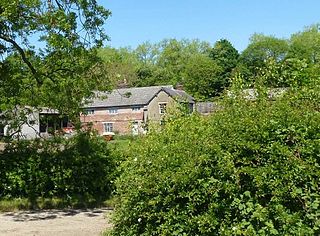
Garrett Hall or The Garrett is a former manor house and now a grade II listed farmhouse in Tyldesley, Greater Manchester, England. The hall was designated a grade II listed building in 1987.
Walton Hall was a 17th-century historic country house, set in a 300-acre (1.2 km2) estate, which was demolished in the early 20th century. Sometimes referred to as Walton Old Hall, it was situated at the centre of the Walton Hall Park in Walton, Liverpool. Its former residents were Liverpool merchants and the last two families to reside at Walton Hall profited from the Atlantic slave trade. In the 19th century it was the home of Thomas Leyland during his second and third term as Lord Mayor of Liverpool.
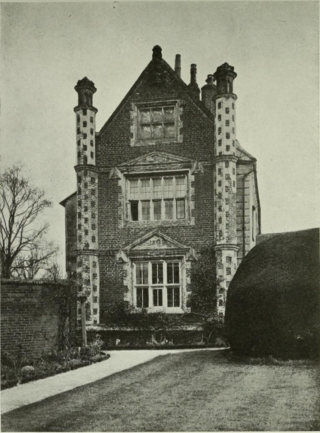
Doreward's Hall is a partly brick and partly timber-framed and plastered house in Bocking, Essex, England. The house is said to have been rebuilt by Edward Thursby in 1579, but may be of earlier date; the date, 1572, on the southwest end of the West wing is said not to be original. It has been modified a number of times since then. It was designated a Grade II* Listed Building in 1951.















